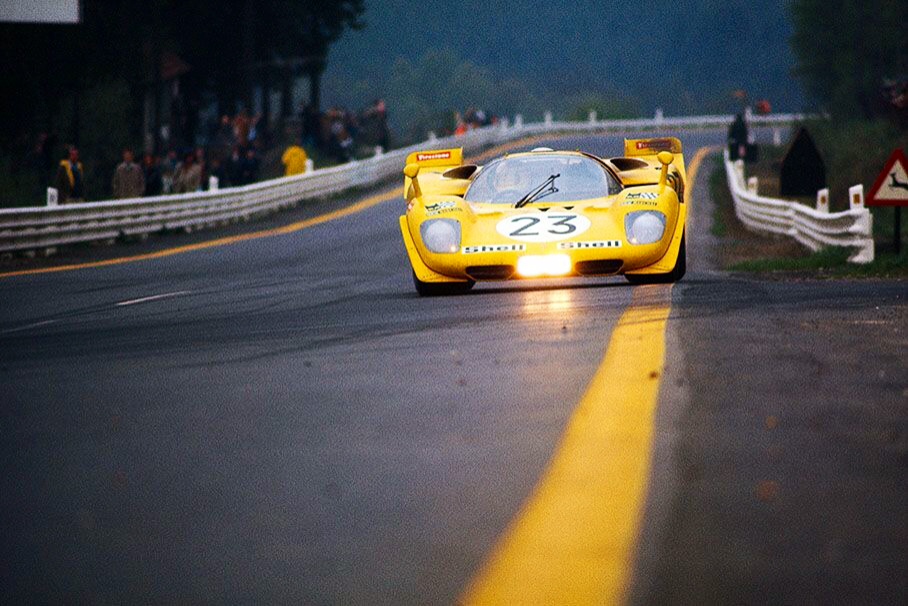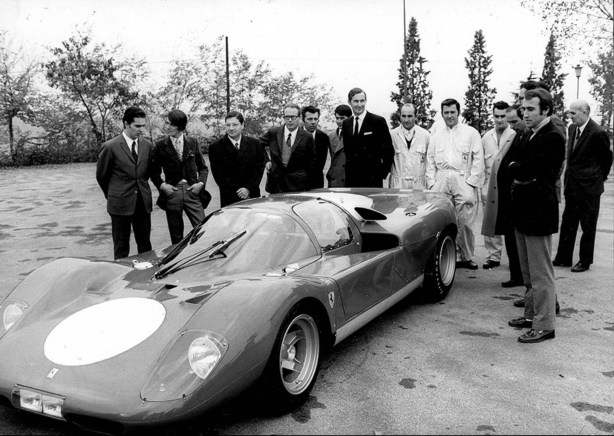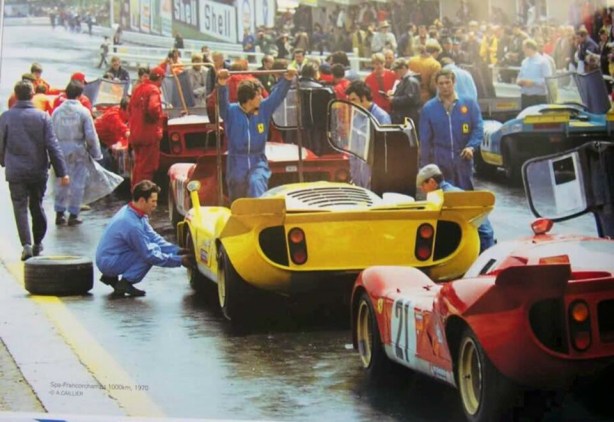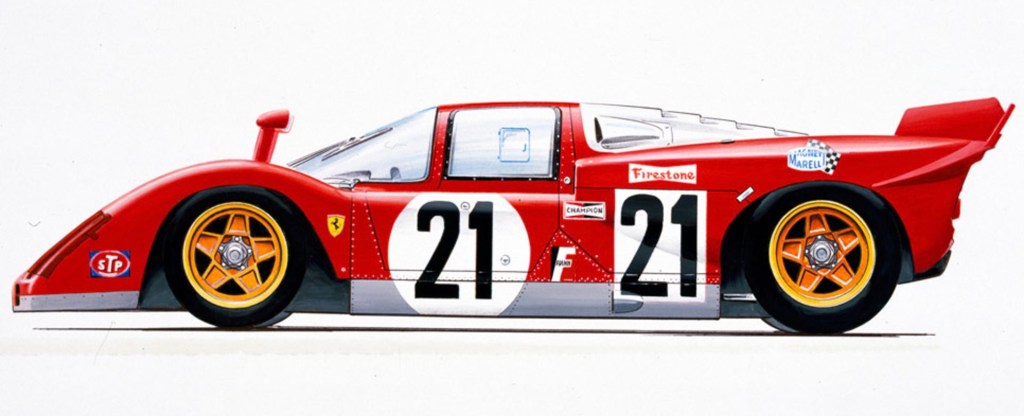
Fabulous shot of Derek Bell bang on the yellow line on the approach to La Source hairpin during the Grand Prix de Spa in 1970, he finished eighth sharing this Ecurie Francorhamps 512S with Hughes de Fierlant…
Jo Siffert and Brian Redman won the race in the dominant car of 1970/71, the Porsche 917K. These 5-litre 12-cylinder, 450-550bhp cars are still spoken of in awe 45 years later by those fortunate enough to see or drive them.
Ferrari were very busy in 1970 with F1 and their beloved sportscar programs. Porsche kept it simple, subcontracting the preparation and racing of their factory cars to John Wyer Engineering and Porsche Salzburg, they were not distracted by F1.

On paper, the V12, spaceframe chassis 512S should have given the flat-12, spaceframe chassis 917 a better run for its money than it did. An early season Sebring 12 Hour win by Ignazio Giunti, Nino Vaccarella and Mario Andretti (above) flattered to deceive in a season the 917 hordes belted Ferrari into submission. What races the 917 didn’t win the lithe, nimble 3-litre flat-8 908/3 did.
Ferrari’s suitably tweaked 512S-1971-updated 512M showed early potential to serve it up to the 917 horde, but the Ferrari factory didn’t race it in ’71, the 15 cars built or converted from 512S spec were raced by privateers, while Scuderia Ferrari raced a single 3-litre 312PB in advance of a change in regulations from 1972. It was strategy that was most effective, but they probably left a win or two on the table in 1971 as a consequence.

Enzo Ferrari, second from the right, and buddies launch the new Ferrari 512S to the press in Modena on November 6, 1969. Key elements of the spiel with this photograph was ‘Latest Ferrari Sports Model’ was a 5000cc 12-cylinder engine producing 550bhp @ 8,500rpm and an ‘extremely low streamlined body with a panoramic cockpit in the forward position.’
Whether the shot below was taken on the same day is unclear, the very tall Mike Parkes stands out mid-pic with liddl’ Art Merzario second left and Clay Regazzoni to the right of the car, closest to us.


25 512S, Maranello late 1969…
Twenty five cars were required by the governing body, the CSI for homologation into Group 5. The cars are all lined up ready for inspection, the yellow Francorchamps car stands out. Porsche were awfully keen for the Ferrari production audit to be as vigorous as their own, the Scuderia’s ability to count having been proved poor in the past, the 250LM springs to mind…
The investment was huge compared with the small production runs of previous models, only three P4s were built, plus one P3 converted to a P4. Fiat acquired 50% Ferrari, taking control of its road car division in 1969 and put racing support arrangements in place going forward. Without that there would have been no 512 program, the company would not have had the working capital to build so many cars with sales of them far from certain.

All the fun of the fair and more 512S all in a row, mechanics fettle Bell’s car, #21 is the seventh placed Schetty/Merzario Scuderia Ferrari 512S, the best placed 512S was the Ickx/Surtees machine in second.
Technical Specifications…


“Put together in just three months by a team headed by Mauro Forghieri”, Ferrari wrote. The steel tubular space frame chassis was developed with learnings from the P4 and 612, with the polycarbonate Berlinetta and Spyder bodywork designed by Giacomo Caliri.
4.06 metres long, 2 metres wide, 972mm high with a wheelbase of 2.4 metres and front and rear tracks of 1518mm/1511mm. Fuel capacity 120 litres, weight 840kg dry.


Front suspension by upper and lower wishbones, coil springs/Koni shocks and adjustable roll bar. At the rear the period typical layout was adopted as well; single top links, inverted lower wishbones, twin radius rods and again coil spring/Konis. Magnesium uprights and wheels were used and tyre sizes 4.45-11.50-15 inches front and 6.0-14.50-15 inches at the rear. Steering was rack and pinion.


The engine was a Ferrari classic 60-degree all-alloy DOHC V12, of 4993.53cc; 87x70mm bore/stroke. The design incorporated four-valves per cylinder, Lucas indirect fuel injection, used a compression ratio of 11.5:1, one plug per cylinder and was of course dry-sumped. Quoted power, as cited earlier was 550bhp @ 8,500rpm. The gearbox had 5-speeds and reverse.

Etcetera…

The Ferrari compound above at Le Mans in 1970.
The Dick Attwood/Hans Hermann Porsche 917K won the race with the best place of the eleven 512S which started the race was the NART entry driven by Sam Posey and Ronnie Bucknum.
#8 is the Art Merzario/Clay Regazzoni entry DNF after 38 laps with a collision, the #5 Jacky Ickx/Peter Schetty was also involved in a collision in which a marshal was killed after completing 142 laps. The car to the left without a number showing is the Derek Bell/Ronnie Petersen car which had a valve fail after only 39 laps- worse was bearing failure of the #6 Nino Vaccarella/Ignazio Giunti 512S after only seven laps were completed. Not a memorable Le Mans for Ferrari at all.

Credits…
ferrari.com, A Caillier, Rainer Schlegelmilch, Getty Images, United Press International
Tailpiece…

Superb Spa panorama in 1970 by Rainer Schlegelmilch shows the seventh placed factory 512S chasing the winning Jo Siffert/Brian Redman John Wyer Porsche 917K.
Finito…
[…] Click here to read it; https://primotipo.com/2014/07/14/ferrari-512s-derek-bell-spa-1000km-1970/ […]